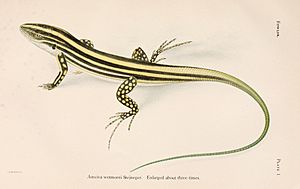Pholidoscelis wetmorei facts for kids
Quick facts for kids Pholidoscelis wetmorei |
|
|---|---|
 |
|
| Conservation status | |
| Scientific classification |
The Pholidoscelis wetmorei is a type of lizard found only in Puerto Rico. It belongs to the family called Teiidae, which are often known as whiptail lizards. People also call this lizard the Puerto Rican blue-tailed ameiva, Wetmore's ameiva, or blue-tailed ground lizard.
Contents
About the Blue-Tailed Ground Lizard
This lizard's scientific name, wetmorei, was given to honor an American bird expert named Alexander Wetmore.
Where Does It Live?
In Puerto Rico, you can find the blue-tailed ground lizard in the dry forests along the southwest coast. It also lives on nearby small islands like Caja de Muertos and Isla Magueyes. These lizards prefer very hot and dry places.
What Does It Look Like?
The blue-tailed ground lizard is a medium-sized lizard. Males can grow to about 52.4 millimeters (2.06 inches) long from their snout to the base of their tail. Females are a bit smaller, reaching about 49.9 millimeters (1.96 inches).
Their bodies are mostly black. Their bellies can be creamy white or a coppery red color. They have 7 to 9 tan or brown stripes that run from their head all the way to their tail.
The most special thing about this lizard is its tail! It's a bright turquoise blue or green. This bright color goes all the way around the tail, making it easy to spot.
How Is It Different from Other Lizards?
The blue-tailed ground lizard (P. wetmorei) is smaller than another common lizard in Puerto Rico, the Puerto Rican ground lizard (P. exsul).
Young Puerto Rican ground lizards also have a blue tail, but they lose this color as they get older. The blue-tailed ground lizard keeps its bright blue tail even when it's an adult. This helps tell them apart! Where their homes overlap, the blue-tailed ground lizard is more common and does better than the other lizard.
Daily Life and Habits
These lizards love dry places and are active during the day. They are often found hiding under rocks and logs. They are most active when the sun is hottest.
Blue-tailed ground lizards look for insects and small fruits to eat. Females can carry up to three eggs at a time. They usually lay at least two groups of one egg each year.
What Dangers Does It Face?
The blue-tailed ground lizard faces two main threats:
- Being hunted: Animals like small cats and mongooses, which were brought to Puerto Rico, hunt these lizards. This affects how many lizards there are.
- Losing its home: These lizards need very specific hot and dry forest habitats to live and find food. If these dry forests are destroyed, the lizards lose their homes.


